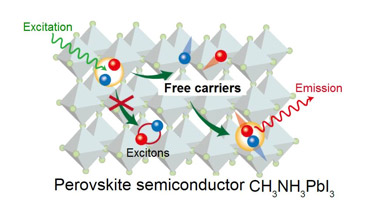Electrons behave freely in perovskite PV cells
A team at the Institute for Chemical Research of Kyoto University has clarified the behavior of electrons and holes in organometal halide perovskite semiconductor (CH3NH3PbI3), which is a focus of growing interest as one of the most promising next-generation solar cells.
In the few years since the first announcement of the perovskite PV cell by another Japanese research institute in 2009, the conversion efficiency of solar cells employing perovskite semiconductor has soared from around 3% to 19.3%, which is the latest result reported. This rapid progress is fueling speculation that perovskite PV cells could soon catch up with the conversion efficiency of crystalline silicon cells and possibly pull ahead. Like other organic PV cells, the perovskite PV cell can be fabricated by coating the material on a substrate or film, which would greatly lower the production cost of solar cells.
The research team, led by Associate Professor Yasuhiro Yamada, pointed out that the physical properties of perovskite semiconductor had not been unraveled despite growing interest in the material. In particular, the behavior of electrons in the material was a mystery. They set out to answer the big question: do the electrons and holes form electrically neutral excitons or exist and move freely?

The team radiated a laser pulse on the perovskite film for 300 femtoseconds and observed the change of emission strength and light absorption. The team found that emission strength was proportional to the square of the strength of the exposed laser beam. This phenomenon is known to be attributable to the collision of free electrons and holes, whereas excitons do not bring about the phenomenon. Therefore, the team concluded that electrons and holes in the perovskite film do not form electrically neutral excitons but exist as charged electrons and holes, moving freely. Therefore, as in the case of other non-organic semiconductors, electrons and holes can be driven by applying a voltage.
The results were reported in a paper entitled "Photocarrier recombination dynamics in CH3NH3PbI3 thin films" in the online version of the Journal of the American Chemical Society on July 30, 2014.
Related site:
Abstract in the Journal of the American Chemical Society (Jul. 30, 2014)
Warning: Invalid argument supplied for foreach() in /home2/semicon/hosting/spiwww/include/Banner.php on line 78
Warning: array_multisort(): Argument #1 is expected to be an array or a sort flag in /home2/semicon/hosting/spiwww/include/Banner.php on line 81
Warning: Invalid argument supplied for foreach() in /home2/semicon/hosting/spiwww/include/Banner.php on line 85




